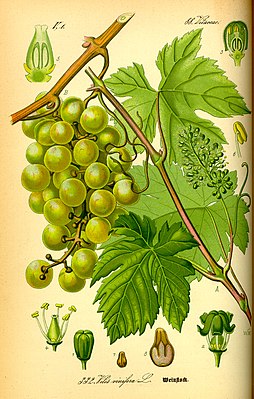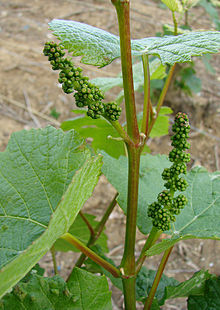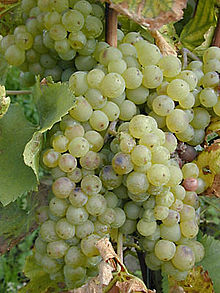Noble grapevine
| Noble grapevine | ||||||||||||
|---|---|---|---|---|---|---|---|---|---|---|---|---|

Noble grapevine ( Vitis vinifera ), illustration |
||||||||||||
| Systematics | ||||||||||||
|
||||||||||||
| Scientific name | ||||||||||||
| Vitis vinifera subsp. vinifera | ||||||||||||
| L. |
The noble grapevine ( Vitis vinifera subsp. Vinifera ), also called real grapevine , also called wine , is a subspecies of Vitis vinifera within the genus of the vine ( Vitis ). It is cultivated systematically in order to harvest grapes that are sold as table grapes and raisins or are processed into wine or grape juice . Like most useful plants , the noble grapevine comes in different varieties , which are called grape varieties in viticulture .
history
The grapevine is one of the oldest cultivated plants . As early as 5000 BC The cultivation of grapevines can be documented for the first time in the South Caucasus (today Georgia ) and in the Middle East Sumer (today southern Iraq ).
biology
The vine is a sympodial constructed liana , which can reach a growth height 2-10 meters. The tip of each sympodial member (with two knots) ends in a branch tendril that is pushed off to the side. Each sympodial link corresponds to a long drive or Lotte . In addition, short shoots emerge from the axils of the buds, which are referred to as stinging and which the winemaker "maxed out" because they inhibit the development of the inflorescences or fruit clusters that are growing at the same time by taking away these nutrients and hindering the ventilation of the vine . The 3 to 5 lobed leaves are long stalked and round to heart-shaped in outline.
The above-ground part of the plant consists of the perennial wood and the shoots that form in the course of the new growing season. These shoots carry the leaves, with the help of which the plant carries out photosynthesis. After the vines have bloomed, the vines develop fruit sets from which the grapes develop. Each grape consists of a large number of berries that are connected to each other by fine branches, the combs, also known as blackberries. These berries store sugar over the course of the growing year. As long as the plant can photosynthesize (recognizable by the leaves that are still green), it is able to form sugar, whereby the phase in the last few weeks before the harvest is crucial. Ideally, the grapevine can produce up to 1 degree of Oechsle in sugar per day during this period . Optimal conditions for photosynthesis are temperatures of 25 to 28 degrees and an illuminance of 20,000 lux. The sugar concentration is also influenced by natural growth conditions such as sun and wind (increases concentration) or rain (dilutes concentration). During the ripening phase (from the softening stage in the course of August) in autumn, the energy from the sugar is used to synthesize the varietal ingredients (aromas and colors) in the berry.

The inflorescences or pebbles appear in May to June. According to the botanical-morphological definition, the inflorescences are not grapes , but panicles . The flowers are mostly hermaphroditic. From September the spherical fruits appear, which are 6 to 22 mm in size. Depending on the cultivar, these are green, yellow, dark purple or blue-violet.
The number of chromosomes is 2n = 38, 57 or 76.
ancestry
The noble grapevine was bred about 7000 years ago in an area around Palestine , Syria and the Aegean Sea from the wild grapevine , which, in contrast to the cultivated form, is dioecious and cross-pollinated. In the course of the breeding process, the berries became bigger and sweeter.
Economical meaning
The noble grapevine is one of the most important agricultural crops worldwide. In almost all countries with temperate and subtropical climates , grapevines are grown for various purposes. Above all, the production of wine, table grapes and raisins should be mentioned here. But the leaves of the noble grapevine are also important for the manufacture of pharmaceutical products.
use
Production of wine and table grapes :
Processing of grapes into wine:
Processing into grape juice:
Processing into brandy:
Grape seed oil production:
Medical use
As a remedy in the broadest sense, not only the drink wine and grapes , but also the other components of the noble grapevine were and are used :
Preparations made from red vine leaves
These contain red grapevine leaves, mostly in the form of dry extracts. The quality of the leaves and an extract is described in the French Pharmacopoeia (Ph.Franc X). These are leaves of grape varieties that are called teinturier or dye vines . As active substances they contain flavonoids , mainly quercetin - glycosides and kaempferol 3-glucoside (also astragalin called). The red color is due to anthocyanins . In addition, there are proanthocyanidins and other phenolic compounds known as polyphenols . A dried extract from red grapevine leaves (4–6: 1), extracting agent: water, approved as a medicinal product, is used in rational phytotherapy with the “evidence-based” indication for the treatment of complaints in diseases of the leg veins ( chronic venous insufficiency , CVI) , such as Example pain and heaviness in the legs, night cramps, itching and edema. The medicinal use of vine leaves already has a long history, beginning with the Roman doctor Galenus and leading to phytotherapy with red vine leaves in the 20th century .
Grape skin extracts
The skins of the red grape varieties in particular contain the active ingredients resveratrol and oligomeric proanthocyanidins (OPC). Resveratrol is a trihydroxystilbene. It has anti-carcinogenic potential and protects the heart and blood vessels. In the plant it acts as phytoalexin and protects it against plant diseases such as B. from fungal infections. Grape peel extracts are contained in dietary supplements in which OPC is said to act as an antioxidant and free radical scavenger.
Grape seed extracts
Grape seed extracts contain approx. 80% oligomeric proanthocyanidins (OPC) in addition to other polyphenols. Because of their antioxidant effects, they are contained in food supplements as so-called protective substances for the cardiovascular system. Around 150 mg of extract is recommended as a daily dose. In addition, the extracts are added to cosmetics as indirect UV protection.
Pests and diseases of the grapevine
Numerous pests and diseases occur on the grapevine. In addition, due to unfavorable site conditions, physiological disturbances can occur, which can lead to yield reductions or losses.
literature
- C. u. F. Lange: Das Weinlexikon , Fischer Verlag 2003, ISBN 3-596-15867-2 .
- Helmut König & Heinz Decker: Kulturgut Rebe und Wein , Springer-Verlag, Berlin et al. 2013, ISBN 978-3-8274-2886-8 .
Individual evidence
- ^ Erich Oberdorfer : Plant-sociological excursion flora for Germany and neighboring areas . 8th edition. Verlag Eugen Ulmer, Stuttgart 2001, ISBN 3-8001-3131-5 . Page 643.
- ↑ Domestication history: Domestication of plants and animals. Lecture notes from the University of Basel (PDF; 8.7 MB).
- ↑ Ernst Rühl & Joachim Schmid: The vine as a cultivated plant, In: Helmut König & Heinz Decker: Kulturgut Rebe und Wein. Springer-Verlag, Berlin et al. 2013, p. 69.
- ↑ Peter Dilg: Wein, -rebe, -stock (Vitis vinifera), I: Medical use. In: Lexicon of the Middle Ages . Volume 8 (1997), Col. 2130.
- ↑ Pharmacopée francaise (PF10), 10ème édition, Agence française de sécurité sanitaire des produits de santé. Monograph VIGNE ROUGE, EXTRAIT DE VIGNE ROUGE (SEC) , Jan 1996.
- ↑ Agnès Boucheny, Michèle Brum-Bousquet: Contribution à l'étude de la feuille de vigne rouge (Vitis vinifera L.) . In: Plantes Médicinales et Phytothérapie , Jg. 24, 1990, pp. 179-192.
- ↑ Ernst Schneider, Holger von der Heydt, Anke Esperester: Evaluation of polyphenol composition in red leaves from different varieties of Vitis vinifera L. ssp. vinifera . In: Planta Medica . Vol. 74, 2008, pp. 565-572.
- ^ Ernst Schneider: Rotes Weinlaub - a vein-effective medicinal drug . In: Deutsche Apotheker Zeitung . Vol. 147, No. 30, 2007, pp. 3380-3386.
- ↑ ESCOP Monographs. The scientific foundation for herbal medicinal products. '' VITIS VINIFERAE FOLIUM, Red Vine Leaf ''. Second Edition Supplement. Stuttgart: Thieme 2009.
- ↑ C. de Mey: The edema-protective effectiveness of Antistax in chronic venous insufficiency. A comment from the perspective of evidence-based medicine. In: Advances in Medicine 2000; Vol. 118 (Originals No. III), pp. 125-133.
- ↑ Ernst Schneider: Rotes Weinlaub - history of use . In: Journal of Phytotherapy . Vol. 28, 2007, pp. 250-258.
- ↑ Evan H. Siemann, Leroy L. Creasy: Concentration of the Phytoalexin Resveratrol in Wine . In: American Journal of Enology and Viticulture . Vol. 43, No. 1, 1992, pp. 49-52.
- ↑ Minnie Holmes-McNary, Albert S. Baldwin: Chemopreventive properties of trans-resveratrol are associated with inhibition of activation of the IκB kinase . In: Cancer Research . Vol. 60, 2000, pp. 3477-3483.
- ↑ P. Langcake, CA Cornford, RJ Pryce: Identification of pterostilbene as a phytoalexin from Vitis vinifera leaves . In: Phytochemistry . Vol. 18, No. 6, 1979, pp. 1025-1027.
- ↑ Ezio Bombardelli, Paolo Morazzoni: Vitis vinifera L. In: Fitoterapia . Vol. 66, No. 4, 1995, pp. 291-317.
- ↑ J. Vidaud, p Charmont and R. Wagner: Le raisin de table - , Ctifl, 1993, pp 283-291, ISBN 2-7380-0676-0 , ISSN 1144-7605
Web links
- Vitis vinifera L., sl, grapevine. In: FloraWeb.de.
- Vitis vinifera L., s. str., real grapevine. In: FloraWeb.de.
- Profile and distribution map for Bavaria . In: Botanical Information Hub of Bavaria .
- Noble grapevine . In: BiolFlor, the database of biological-ecological characteristics of the flora of Germany.
- Vitis vinifera L. In: Info Flora , the national data and information center for Swiss flora . Retrieved December 6, 2015.
- Thomas Meyer: Data sheet with identification key and photos at Flora-de: Flora von Deutschland (old name of the website: Flowers in Swabia ).
- Günther Blaich: data sheet with photos.
- Rolf Blaich, University of Hohenheim: Lecture Biology of the Vine (accessed September 12, 2011)
- The organic gardener: grapevines
- Pictures with vein diseases
- Rolf Blaich: Lectures on many topics about grapevines at the University of Hohenheim. (last accessed January 25, 2020)
- Effects of climate change on viticulture



